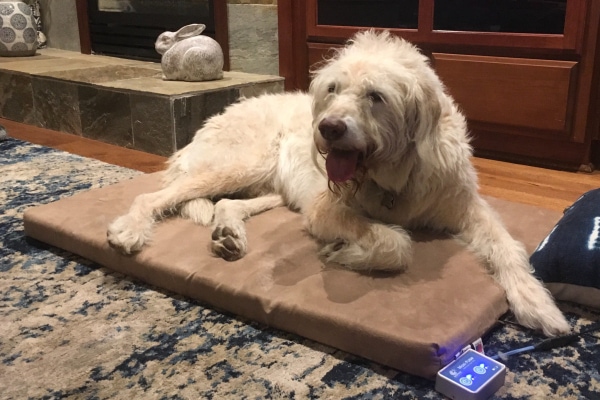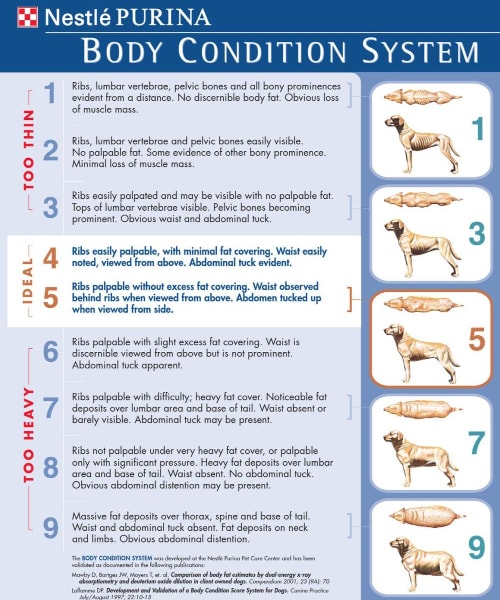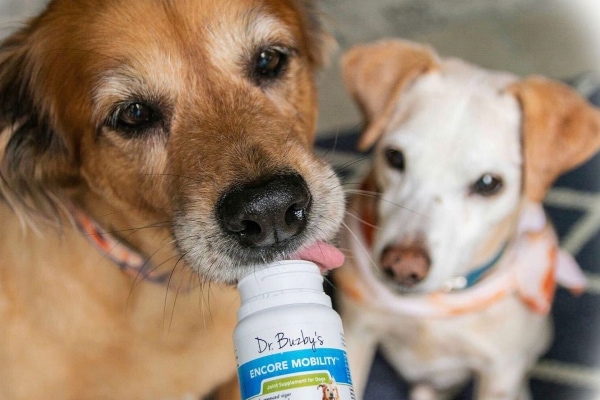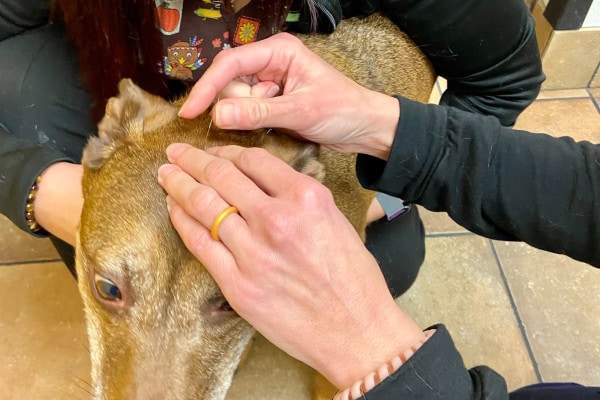There are more ways than ever to provide natural pain relief for dogs. So whether you are looking for supplements, therapies, or other holistic options, you have come to the right place. Integrative veterinarian Dr. Julie Buzby lists and explains her top 17 methods for natural pain relief for dogs. With all these choices, you are sure to find something that works for your dear dog.

The close bond we share with our dogs makes it particularly heartbreaking when they are in pain or unable to do the things they once loved. It is easy to feel lost, helpless, or overwhelmed.
All of this was true for my client and his 8-year-old Airedale Terrier. My sweet patient used to love competing in dog shows and agility with her dad. But recently she had started slowing down. Her energy was decreasing, arthritis was starting to set in, and she was becoming stiff and sore. It seemed her agility days might be coming to an end.
My client explained that he wanted to help his dog get back to doing the things she loved. Since he was hoping to avoid prescription pain medications, he asked me about natural pain remedies for dogs. As a holistic veterinarian, I was more than happy to run through my top 17 dog natural pain relief options with him. And I’d like to share my list with you as well.
But first, let’s get a common understanding of what pain looks like for dogs.
How do I know if my dog is painful?
Pain can look different depending on the dog’s personality, pain tolerance, and the source of the pain. Some common signs a dog is in pain include:
- Limping
- Decreased appetite
- Whimpering/crying out (especially if the affected area is touched)
- Excessive licking or chewing of an area
- Decreased energy
- Drainage or discharge from affected area
- Hiding or withdrawing from the family
- Becoming aggressive
- Holding the ears back or grimacing
- Hunched or abnormal posture
- Difficulty getting comfortable to sleep or rest
If you suspect your dog is in pain, some of the 17 natural pain remedies for dogs that I am about to discuss might help him or her be more comfortable.

17 ways to provide natural pain relief for dogs
Before jumping in to the various natural pain remedies for dogs, I do want to make two things very clear:
- It is always best to talk to your vet when you think your dog is in pain. Your vet can help you determine if natural pain relief is right for your dog, and if so, which options are best. Not every natural pain relief method is right for every condition or every patient.
- Sometimes a dog may also need “non-natural” pain relief to control his or her pain adequately. This may involve using non-steroidal anti-inflammatories (NSAIDs), gabapentin for dogs, tramadol for dogs, amantadine for dogs, or other medications. Or the dog may need an orthopedic surgery, dental procedure, or other intervention or treatment.

With those two warnings in mind, let’s dive into the natural pain relief options. Broadly speaking, these remedies fall into one of three categories—home remedies for a dog’s pain, pain-relieving supplements, and alternative medicine modalities.
5 home remedies for a dog’s pain
There are plenty of things you can do at home to comfort a dog who is in pain.
#1. Cold therapy
If you are an athlete or have suffered an orthopedic injury in the past, you may already be familiar with cold therapy as a method of natural pain relief. It involves applying something cold, usually an ice pack, to a dog’s joints or limbs. Cold can decrease muscle spasms and reduce swelling and inflammation, which in turn reduces pain.
To safely perform cold therapy on your dog, grab an icepack and a shirt or towel. Flexible icepacks or even a bag of frozen veggies (that you don’t plan to eat) tend to conform to the shape of the dog’s leg better, and are therefore more comfortable for your dog, than a rigid ice pack.
To prevent damage to your dog’s skin from the cold, always place a cloth such as a towel or shirt between your dog’s skin and the icepack. And do not leave the icepack on for a prolonged period of time. Remove the icepack after about 15 minutes, or sooner if your dog seems painful or uncomfortable.
Generally, you can repeat cold therapy about every 6-8 hours. However, it is best to check in with your vet about whether cold therapy is right for your dog and how he or she wishes you to perform the cold therapy.
#2. Pulsed electromagnetic field therapy (PEMF)
Pulsed electromagnetic field (PEMF) therapy is another one of the home remedies for dog pain. As the name suggests, PEMF works by combing magnets and electric fields. PEMF therapy for dogs stimulates cell communication that may have been interrupted due to injury or disease. By stimulating this communication, it also promotes cell processes that are important for healing and pain relief.
The effects of PEMF lead to:
- Cell multiplication (necessary for wound healing)
- Collagen formation (can help with tendon and muscle injuries)
- Reduction of pain and inflammation
- Increased circulation and tissue oxygenation (also helps wound healing, joint pain, and fracture healing)

PEMF should not have any negative side effects on your dog. Additionally, this is a treatment option that can be done from the comfort of your own home. After consulting with your veterinarian, you can purchase a PEMF bed or mat for your dog. This looks like a normal dog bed but when your dog lays on it, he or she can receive PEMF treatments right in your living room.
#3. Massage therapy
Massage can feel good to our dogs, just like it does for us. It improves blood flow to the affected area, reduces pain, stiffness, and inflammation, and relaxes your dog. Technically, massage therapy actually falls into two categories of natural pain relief for dogs—home remedies and alternative medicine.
For the most benefit, you should bring your dog to a rehabilitation professional who is skilled in canine massage. They will know exactly how to safely and effectively manipulate your dog’s tissue for maximal pain relief.
However, it is also possible to learn how to massage your dog at home. Generally, you would start with a stroking motion then move on to kneading and rubbing the area. However, the exact technique can vary depending on your dog’s needs. If you are interested in learning how to massage your dog at home, please consult with your vet or a rehab professional for more specific instructions.
When performing the massage, keep your own safety in mind. If your dog is growling, nipping, or does not want you touching him or her, do not continue the massage therapy. Otherwise your dog could end up biting you as a means to get you to stop.
#4. Maintaining proper body weight
This probably doesn’t come as a shock to you, but keeping your dog at a healthy body weight is very important for helping him or her live a long, healthy life. In fact, a study with Labrador Retrievers demonstrated that dogs who were a healthy body weight lived an average of two years longer than their chubbier counterparts. Plus, weight loss (if indicated) is a medication-free way to help reduce your dog’s pain.

Weight management is especially important for dogs struggling with bone, nerve, or joint pain. In these cases, the extra weight puts more strain on the affected area. Even a small amount of weight loss can make a huge difference for an arthritic dog.
Determine your dog’s body condition score and create a plan
If you are wondering, “Is my dog overweight?”, start by determining your dog’s body condition score (BCS). The BCS looks at dog’s frame and is typically a more accurate representation of your dog’s weight than the number on the scale.
Should you determine weight loss is in order, keep in mind that your veterinary team is a great resource for tips and tricks for how to help a dog lose weight. While it might be challenging, sticking to the plan will be worth it in the end.
By reducing your dog’s weight (or maintaining him or her at a good weight), you are decreasing the load on your dog’s painful joints and increasing the chances you will have more time with him or her.

#5: Exercise
Along the lines of managing weight, exercise can also be a great medication-free way to help relieve your dog’s pain. By routinely exercising, dogs will develop stronger muscles and improve their overall fitness level. The end result is muscles, tendons, and ligaments that can better support the load on the joints as the dog runs, walks, or plays. This translates to less pain for your dog.
Keep in mind, though, that you do need to be mindful of how much exercise you ask a painful dog to do. Sometimes dogs don’t know what is good for them so they will keep on running, jumping, and playing as long as you want to. Then they will pay for it later with increased pain and soreness. If your dog has orthopedic issues, it is best to speak with your vet about what kind of exercise (swimming, walking, etc.) and duration of exercise is best for your dog.
Also, take your time when working up to longer duration or higher intensity exercise. Just like people, dogs also need time to get in shape.
6 supplements or other substances that provide natural pain relief
There are a variety of supplements which can help decrease your dog’s pain, especially if your dog is mostly dealing with orthopedic issues.
#1. Green lipped mussel
Green lipped mussels are only found along New Zealand’s coastline and have been used by the indigenous Maori people of New Zealand for centuries. Recently, green lipped mussel has become popular with veterinarians and dog owners as a supplement because of its natural anti-inflammatory properties.
Reducing pain and inflammation
Being naturally rich in omega-3 fatty acids — specifically eicosapentaenoic acid (EPA) and docosahexaenoic acid (DHA)— green lipped mussel for dogs helps reduce inflammation and support immune health. EPA and DHA reduce pain and inflammation by preventing the body from producing “inflammation and pain signals.” Interestingly, this is actually the same way non-steroidal anti-inflammatory drugs (NSAIDs) like carprofen for dogs work.
While I use and recommend NSAIDs for my own dogs and my patients, the downside is that they can occasionally have detrimental side effects. Particularly when used for chronic pain over long periods of time, NSAIDs can negatively affect the kidneys, liver, and stomach. However, green lipped mussel has minimal side effects, which makes it a safer anti-inflammatory for some dogs.
Repairing and supporting joints
In addition to its anti-inflammatory effects, green lipped mussel can also help support the joints. It provides the building blocks needed to repair cartilage and increase joint lubrication. Plus, its vitamins and minerals help slow down damage to cells and promote overall joint health.
#2. New Zealand deer velvet
Another one of the best natural pain relief options for dogs comes from New Zealand too—New Zealand deer velvet. Deer velvet is the immature stage of the antler, which is harvested humanely using local anesthetic and then used to produce supplements.
Deer velvet has been successfully used in Chinese medicine for over 2,000 years. Among other things, it is an excellent natural remedy for a variety of joint-related issues.
One of the unique components of deer antler velvet is insulin-like growth factor 1 (IGF-1). IGF-1 is responsible for the rapid growth of a deer’s antlers (which have a large cartilage component), so it makes sense that it can also promote cartilage growth and help with joint repair. Plus, deer antler velvet is chock full of other joint-support ingredients such as omega-3 fatty acids, hyaluronic acid, glycosaminoglycans, chondroitin sulfate, and glucosamine.
Deer velvet supplements for dogs can help provide pain relief by
- Reducing pain and inflammation of the joint
- Promoting tissue health and healing of tendons and ligaments
- Encouraging wound healing
- Helping with fracture repair

Plus, deer velvet has other great effects on the heart, immune system, red blood cells, adrenal glands, and brain.
#3. Omega-3 fatty acids
Omega-3 fatty acids for dogs are known as “essential” fatty acids because dogs are unable to synthesize them. Instead, they must consume sufficient quantities of omega-3 fatty acids to keep their body functioning correctly. Dog food tends to contain some omega-3s, but not always enough to be beneficial. Thus, dog parents may turn to fish oil supplements because cold water fish are a rich source of omega-3s.
Reduce inflammation
As previously discussed, omega-3s such as DHA and EPA have potent anti-inflammatory effects that target the same inflammatory pathway as NSAIDs. Plus, they can promote joint health. This combination of factors makes them a great natural remedy for arthritis or swollen joints.
Promote a healthy skin and coat
Another wonderful benefit of omega-3 fatty acids is that they improve skin and coat health. This makes them a great option for dogs who are suffering from dry and cracked skin. Plus, the anti-inflammatory properties of omega-3s can provide relief for dogs who are painful from allergies and excessive scratching.
(It is important to note, though, that for dogs with severe allergies or skin disease, omega-3s alone may not be sufficient to resolve the clinical signs. These dogs may also need prescription allergy medicine for dogs, so it is best to make an appointment with your vet.)
Boost heart, kidney, and brain health
Amazingly, the benefits of omega-3s don’t stop there. They also have been shown to be beneficial in patients with heart disease in dogs, kidney failure in dogs, and signs of dementia in dogs. Plus, omega-3 may play a role in treating lymphoma in dogs or other cancers. By helping manage these diseases, omega-3 fatty acids may be able to reduce the pain associated with them.
#4. Glucosamine and chondroitin
Glucosamine and chondroitin sulfate are both naturally occurring gycosaminoglycans (GAGs), which are the building blocks of cartilage. If you pulled a variety of joint supplements for dogs off the shelf, there is a good chance that most (or maybe all) of them would contain glucosamine and chondroitin sulfate.
This combination of glucosamine and chondroitin is popular because it is so effective at promoting joint health. Glucosamine and chondroitin work by supporting and protecting cartilage, which normally serves as a cushion or pad between joints. Preserving and repairing the cartilage cushion can help reduce the risk that the two bones that make up the joint will painfully rub against each other. These ingredients may also block molecules that damage cartilage or cause inflammation.
The joint-support functions of glucosamine and chondroitin make them great natural pain relievers for dogs with hip dysplasia, a spinal disc injury, torn cranial cruciate ligaments, and dogs recovering from joint surgery. Plus, glucosamine can also prevent pain by delaying the progression of joint diseases like arthritis.
#5. Herbal medications
There are a variety of herbal medications that can potentially help relieve pain. If you wish to pursue this avenue, it can be helpful to consult with a veterinarian who is trained in traditional Chinese veterinary medicine (TCVM). He or she can help find the herbs or combinations of herbs that will best treat your dog’s particular problem.
#6. CBD oil
This natural pain relief remedy, CBD oil, is not as cut-and-dry as the previous ones. However, it is still worth mentioning.
The Cannabis plant contains many natural compounds, but there are two that most people are familiar with—CBD and THC. CBD is the one that has potentially useful properties from a medical standpoint.
On the other hand, THC is the element associated with marijuana that causes the “high” feeling. It is toxic to dogs and can cause incoordination, lethargy, decreased heart rate, and sometimes seizures. Therefore, if you are considering using CBD oil for dogs as a natural pain reliever, it is important to ensure that there is no THC present.
Researchers are still conducting studies on the uses of CBD oil in humans and animals. So far, there have been two useful research studies looking at CBD in dogs. One small study demonstrated that it reduced seizure frequency in dogs with seizure disorders. Another study on Pharmacokinetics, Safety, and Clinical Efficacy of Cannabidiol Treatment in Osteoarthritic Dogs showed that CBD was safe to use in conjunction with NSAIDs and joint supplements and lead to an improvement in arthritis symptoms in dogs.
Cautions when using CBD oil
However, there are a few issues with using CBD in dogs:
- It is a supplement so it is not as strictly regulated by the FDA. This means that the purity and concentration of the CBD may vary widely from what the label indicates.
- Some CBD oil products contain potentially deadly contaminants like pesticides, arsenic, or fungal toxins.
- Rules vary from state to state on whether veterinarians can legally discuss or recommend CBD oil to their patients.
In the coming years I hope that there are more studies on CBD oil for dogs and more clarity around how/if veterinarians can legally prescribe it. Until then, CBD remains as a “use at your own risk” product in my book.
6 Alternative therapy options
Additionally, veterinarians and veterinary rehabilitation professionals have a wide range of alternative medicine modalities at their disposal that can provide natural pain relief for dogs.
#1: Physical therapy
Just like when you or I are injured, working with a veterinary rehabilitation professional (i.e. dog physical therapist) can be extremely beneficial for dogs with orthopedic issues. By participating in rehab, dogs often return to normal faster after an injury or surgery. The benefits of rehabilitation therapy for dogs include:
- Promoting safer return to exercise following a period of crate rest for dogs—the rehab professional can monitor and assess your dog to ensure he or she doesn’t overdo it.
- Allowing for stretching of muscles and tendons—this helps your dog relax, relieves pain associated with tension, and improves range of motion.
- Teaching you and your dog specific exercises you can do at home to aid in healing and help your dog regain function.
- Providing non-surgical treatment for torn ACLs in dogs or other injuries where surgery isn’t a good option.
- Rebuilding strength and mobility after orthopedic surgery such as hip replacement in dogs, TPLO in dogs, or dog leg amputation.
#2: Chiropractic for dogs
Not only are there dog physical therapists, but there are also dog chiropractors. If you have ever been to a chiropractor for a stiff neck or back, you know that they can do wonders for making you feel better. The same type of relief is possible for our canine friends.
Veterinary chiropractors detect problems that affect specific parts of the dog’s nerve pathways and associated joints. Then they make adjustments to the affected joints. This jump-starts that part of the nervous system, which allows it to function again and provides immediate relief for your dog. Mobility is restored and your dog’s pain is relieved.
It is likely that after a single trip to the chiropractor you will see your dog experiencing a better range of motion and movement than they did before. However, you need to know that sometimes the first visit can be a bit painful for your dog too. After joints have been restricted for long periods of time, they become stiff, so your dog may need to build up to using them again.
#3: Hydrotherapy
Having just completed some hydrotherapy (aquatic therapy) myself, I can attest to how good the warm water in the therapy pool felt on my sore muscles and joints. And the same is true of hydrotherapy for our canine companions.
Plus, the increased buoyance provided by the water reduces the weight (and therefore the stress) on the dog’s joints. And the resistance of the water helps with conditioning. Together, these properties of the water allow the dog to exercise more comfortably and effectively than he or she could on land.
Depending on your dog’s situation, the rehabilitation professional you are working with may suggest using the underwater treadmill for dogs or therapy pool as part of your dog’s pain relief and rehab program.
#4: Acupuncture
Another form of alternative medicine is acupuncture for dogs. If you are not familiar with acupuncture, it involves inserting very small needles into specific points of a dog’s body. These points are located along lines called meridians. Often the meridians and points correspond with the nervous system.

Targeting these points with the needles stimulates a healing response. This can help decrease pain and inflammation. In fact, acupuncture has been scientifically shown to be just as effective as other treatments for pain like NSAIDs or opioids.
Not only does it work, but acupuncture also does not have any side effects and does not need to be processed by the liver or kidney like medications. This makes it a very safe and effective natural pain relief for dogs.
I like using acupuncture for patients who are suffering from:
- Joint pain from osteoarthritis in dogs, hip dysplasia in dogs, or injuries
- Intervertebral disc disease (IVDD in dogs) and other back problems
- Kidney disease in dogs
- Degenerative myelopathy in dogs
- Pain in other areas of the body
- Nausea or anorexia (i.e. decreased appetite)
#5: Laser therapy
Laser therapy is probably one of my favorite ways to treat pain in dogs (other than supplements). Laser therapy for dogs uses a “cold laser” for pain relief. (This is contrary to a “hot laser” for cutting or cauterizing vessels in surgery.) The cold laser (i.e. therapy laser) uses a beam of light to penetrate into deep tissue without causing any damage. The laser beam causes the cells in the tissues to react in a process called photobiomodulation. This leads to:
- Reduced pain and inflammation
- Accelerated healing
- Promotion of tissue regeneration
- Release of endorphins (the naturally occurring chemical responsible for a “runner’s high,” which fights the perception of pain)
I love laser therapy as a treatment option because it is easily customized and safe for most dogs. The number of treatments, length of sessions, and wavelengths used can all be changed to accommodate your dog’s needs. That way he or she can get maximal benefit from the laser.
From a safety perspective, the main precaution is that laser therapy is not always suitable for dogs with cancer. In some cases, it can increase the growth of the existing cancer. Also, dogs and humans do need to wear special “safety sunglasses” to protect their eyes from the laser light during therapy. Otherwise, laser therapy is safer than NSAIDs because it does not cause side effects on the liver, kidney, or stomach.
#6: Platelet rich plasma (PRP)
Platelet rich plasma (PRP) therapy uses a dog’s own platelets to speed up healing in injured tissues and joints. This makes it a great natural pain relief option for dogs.
While you probably tend to associate platelets with blood clotting, that isn’t all they do. Platelets also contain growth factors and molecules used for cell communication. These substances are necessary for driving the healing process.
PRP for dogs involves drawing a sample of your dog’s blood, concentrating the platelet portion to create platelet rich plasma, and then injecting the PRP directly into the problem area so it can work its magic.
PRP has many uses including:
- Promoting healing of ligaments, tendons, cartilage, and bone
- Assisting with tissue regeneration
- Reducing pain and inflammation
- Stimulating wound healing

Not all pain and all dogs are the same
We have covered 17 potential natural remedies for pain in dogs. But it is important to remember that different conditions cause different types or severities of pain. Plus, dogs are individuals. This means that what works for one dog or one source of pain may not work for another dog or another type of pain.
For example, pancreatitis in dogs causes abdominal pain. And dental disease in dogs or a dog tooth abscess can cause severe oral pain. As you may imagine, pain relief methods that target the joints or muscles aren’t going to be very effective for those conditions.
However, those same modalities may bring welcome relief to an arthritic dog or one who has a luxating patella in dogs, or torn ACL in dogs.
Also, as previously mentioned, while many of the holistic options can knock pain down a notch or two, there are some situations where the dog’s pain is severe enough that he or she also needs traditional pain medications to get sufficient pain relief. This doesn’t mean you should throw the idea of natural pain relief out the window. Rather, by combining pain medications with these natural pain relief modalities, you can minimize the amount of medication your dog needs to remain comfortable.
Your veterinarian can help you assess your dog’s pain level and type so that you can make the best plan possible. It may take some trial and error, but most of the time it is possible to find the right combination of therapies.
Natural pain relief for my patient
Remember my patient from the beginning of this article? Her dad and I talked about the different options for natural pain relief and decided to go with a combination of joint supplements, laser therapy, and physical therapy. This plan has been a game changer for her! While she still has the occasional bad day, they are a lot less frequent, and she is back to enjoying agility competitions with her dad.
Speak with your vet about natural pain relief for dogs
As a holistic veterinarian, I am a huge advocate for finding ways to relieve your dog’s pain naturally. And as you can see from the list above, there are a lot of different remedies out there. Most of the things we talked about are safe and effective when used properly. One or more of them could very well be the perfect solution for your dog’s pain.
However, if you are searching for natural pain relief for dogs, don’t go at it alone. Instead, make an appointment with your dog’s vet. This allows you to find out why your dog is painful. From there you and your vet can figure out whether natural pain relief, natural and “non-natural” pain relief, or some other options is the best plan for your dog.
Which natural pain relief options have worked best for your dog?
Please comment below.


Hi Dr, Buzby,
I have my 15 year old chihuahua on Encore Mobility and it seems to be working well for him! I used to also have him on a fish oil pill but stopped because I wasn’t sure he should be on both. Should I add the fish oil pill back into his routine? What about a glucosamine/condroitin?
He takes gabapentin, rimadyl and telmisartan and then a whole host of supplements (including your MCT oil)! My vet said that its unlikey “too many” supplements would cause problems, but what do you think? He is about 10 pounds.
Thanks so much!
Hi Izzy,
I am so glad you are seeing benefits from Encore Mobility and hope you will be pleased with Brain Boost as well. Green Lipped Mussel (one of the ingredients in Encore Mobility) contains lots of natural Omega 3s and other great components. So, adding in another source of Omega 3s, such as fish oil, may not be necessary. But I agree with your vet that it is very unlikely you would “over do it” with supplements. As long as your vet isn’t worried about interactions with medications or conditions your pup may be facing, I see no reason why adding these extra supplements would be a problem. Wishing you and your senior guy all the best and keep up the good work!
Dr. Buzby: my 15 year old German Shepherd/Pitbull mix has Spondylosing (sp) Arthritis. She is on Carprofen, Amantadine and Gabapentin. She gets a Librella shot every month, along with red-light laser once a week. I feel that all the above is only taking her so far. Her vet took her off the Gabapentin after one bottle because he felt it made her mobility issues worse. She is at the high end of dosing for Carprofen and she now is starting to exhibit agitation, diarrhea, loss of appetite and I’m thinking it’s because of the Amantadine. The Librella shot only lasts for 3 weeks. We tried acupuncture and she ended up in the emergency room the next day with total loss of her hind legs. Her vet wouldn’t even call us to talk about it, but the e.r. said it can cause paralysis. How do I find a veterinarian like you in Tucson, Arizona? All of the vets I’ve taken her to are all about pushing yet another worthless, doesn’t-work drug. I’d like to take her off all medication and try something holistic, but I’m worried about doing that since you suggest working with a vet educated in such. Please advise.
Hi Pamela,
I am sorry your senior girl is still painful despite all the treatments and therapies you have tried. I agree, a holistic approach may be better for your girl. You can also ask for a referral to a specialist if needed. Here is a link to another article that has listings for all the specialists: How Do I Find Veterinary Specialists Near Me and What Do They Do?
You may want to read through the paragraph about holistic vets and also the rehabilitation section. There are links to databases that can help locate a vet in your area. If you are thinking of finding someone that practices Traditional Chinese Veterinary Medicine, here is a link to the world association’s website where you can search that specific database: https://watcvm.org/about/practitioner-directory
Hoping you can find your girl the help and care she needs. Wishing you both the best of luck and keep up the good work!
Hello!
I have been using Dr. Buzby for a little while and noticed my dog biting on his hind quarters. He does have a disc problem but we are monitoring by keeping his weight low and using encore mobility. He is active.
Can you tell me how much chondrotin and glucosamine in the pills. My vet seems to think he needs more to support his disc .
Can you let me know via email below. Thank you
Hi Mary,
You should get a reply via email, but I wanted to post the answer here too just in case!
Sorry to hear that your dog has started biting at his hindquarters and your vet is worried that his disc issues might be flaring up. I’m so happy to hear that he is on Encore Mobility and that you are working hard to keep him lean and active! That is a great combination.
Both the New Zealand Deer Velvet and Green Lipped Mussel in Encore Mobility contain glucosamine and chondroitin sulfate. The New Zealand Deer Velvet also has collagen, as well as dozens of other unique and valuable components for supporting joint health. Because Encore Mobility is a whole food supplement, meaning the ingredients are sourced from actual animal tissues and not made in a laboratory, we can’t provide precise amounts of the individual ingredients. However, we do find that the combination and quantities of joint support components are sufficient for the needs of most dogs who are experiencing musculoskeletal problems. That being said, it is also perfectly fine to give your dog additional glucosamine or omega-3s supplements on top of the Encore Mobility.
You can learn more about the ingredients in Encore Mobility here:
Deer Velvet Supplement for Dogs: One Veterinarian’s Guide
3 Natural Supplements for Dogs Like Yours
I hope that you are able to find some solutions to make your dog more comfortable.
My maktipoo is about 14!years old and has a torn all. I cannot keep him on pain meds forever also we have cats and they keep the dog getting up amd down a lot. I understand he is too old for surgery and the expense is too much. Which of your ideas above work best for this kind of injury and age
Hi Adele,
I am sorry your senior boy is painful and is not a good surgical candidate. I apologize for my confusion, but I am not exactly sure what you are saying he has torn. Without examining your pup myself, it is hard to make recommendations about therapy. I would encourage you to reach out to your vet and ask about what pain relief options are best for your boy’s specific medical needs. They can give you their expert opinion and help guide you as you make decisions about treatment. Wishing you the best of luck and praying for comfort for your sweet boy.
Thank you for an excellent website. Everything is clearly explained and easy to understand.